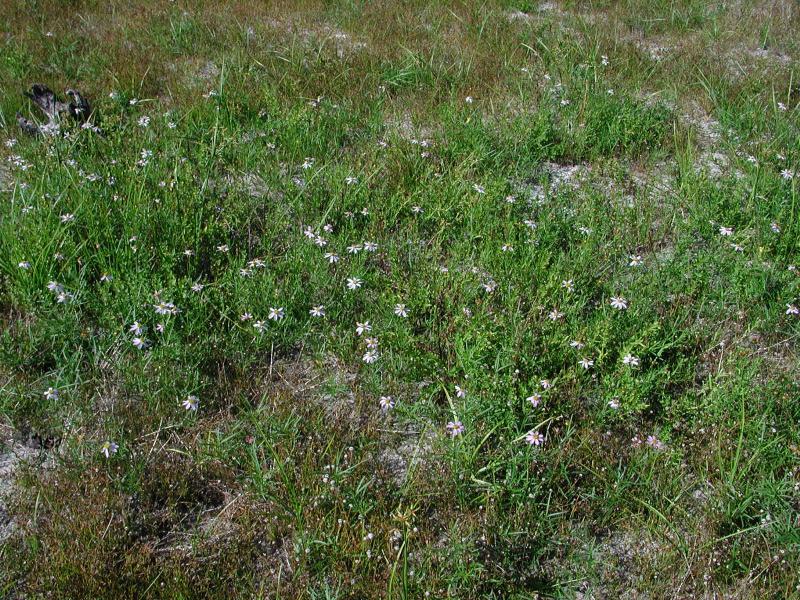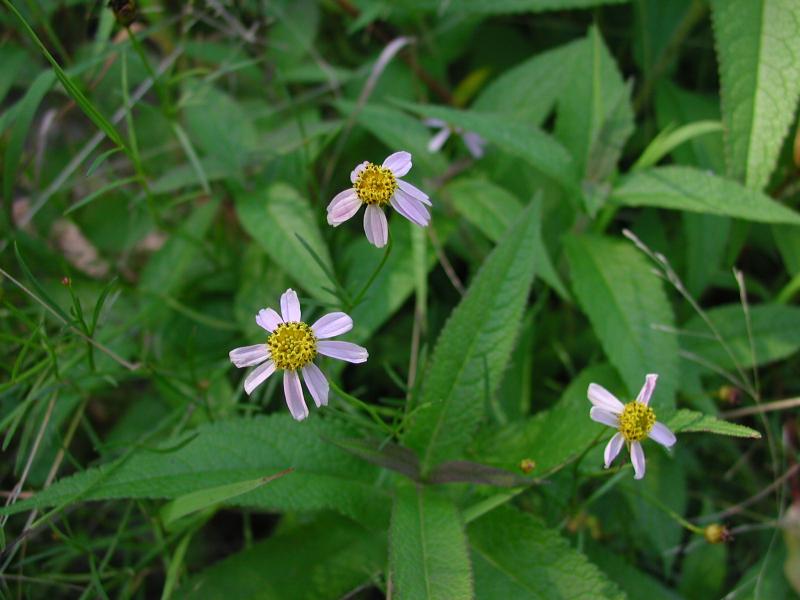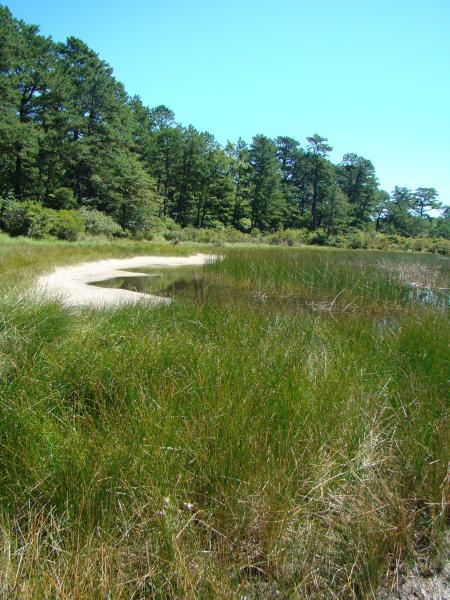Rose Coreopsis
Coreopsis rosea Nutt.
- Class
- Dicotyledoneae (Dicots)
- Family
- Asteraceae (Aster Family)
- State Protection
- Rare
A plant listed as Rare by New York State. Removal or damage without the consent of the landowner is prohibited.
- Federal Protection
- Not Listed
- State Conservation Status Rank
- S3
Vulnerable in New York - Vulnerable to disappearing from New York due to rarity or other factors (but not currently imperiled); typically 21 to 80 populations or locations in New York, few individuals, restricted range, few remaining acres (or miles of stream), and/or recent and widespread declines.
- Global Conservation Status Rank
- G3
Vulnerable globally - At moderate risk of extinction due to rarity or other factors; typically 80 or fewer populations or locations in the world, few individuals, restricted range, few remaining acres (or miles of stream), and/or recent and widespread declines.
Summary
Did you know?
Of the five known species of Coreopsis in New York, this is both our only native species and the only one with pink flowers.
State Ranking Justification
There are 23 existing populations, some of them consisting of multiple hydrologically connected pondshores. There are four additional populations known from the early 1900s which have not been resurveyed.
Short-term Trends
The trend of most populations seem stable but populations can fluctuate dramatically depending upon water levels. A few populations have been negatively affected by Phragmites.
Long-term Trends
Almost all of the known historical populations remain extant so long-term trends remain rather stable. Future trends may be downward if populations of Phragmites are not controlled at occupied sites.
Conservation and Management
Threats
Some ponds have highly developed shorelines that threaten populations with direct disturbance by trampling and ATV use. The invasion of Phragmites is also a threat to a few populations.
Conservation Strategies and Management Practices
The pondshores need to be protected from direct disturbance by ATVs and excessive trampling. Exotic invasive species must be prevented from colonizing the shores and present populations must be eliminated. A natural buffer of at least 200 feet should be established around the ponds to prevent excessive runoff and pollution events.
Research Needs
Research is needed into management techniques that could augment populations that have been reduced by Phragmites.
Habitat
Habitat
Most of New York's populations of Rose Coreopsis have been found growing in or along the shores of Coastal Plain ponds or pools in Pitch Pine Barrens, in open habitats with sandy or peaty substrates (New York Natural Heritage Program 2010). Sandy shores, marsh edges (FNA 2006). Damp sandy, gravelly or peaty shores and depressions (Fernald 1970). Wet, often sandy or acid soil, or in shallow water (Gleason 1952).
Associated Ecological Communities
- Coastal plain pond
(guide)
The aquatic community of the permanently flooded portion of a coastal plain pond with seasonally, and annually fluctuating water levels. These are shallow, groundwater-fed ponds that occur in kettle-holes or shallow depressions in the outwash plains south of the terminal moraines of Long Island, and New England. A series of coastal plain ponds are often hydrologically connected, either by groundwater, or sometimes by surface flow in a small coastal plain stream.
- Coastal plain pond shore
(guide)
The gently sloping shore of a coastal plain pond with seasonally and annually fluctuating water levels. Plants growing on the pond shore vary with water levels. In dry years when water levels are low there is often a dense growth of annual sedges, grasses, and herbs. Submerged and floating-leaved aquatic plants, such as fragrant waterlily and pondweeds, may become "stranded" on the exposed shore. In wet years when the water level is high only a few emergents and floating-leaved aquatics may be noticeable. T
- Gravel mine*
An excavation in a gravel deposit from which gravel has been removed. Often these are dug into glacial deposits such as eskers or kames. Vegetation may be sparse if the mine is active; there may be substantial vegetative cover if the mine has been inactive for several years. Near-vertical slopes are used by bank swallows for nesting sites.
- Pine barrens vernal pond*
(guide)
A seasonally fluctuating pond and its associated wetlands that typically occurs in pine barrens. The water is intermittent, usually a pond in the spring but sometimes losing water through the summer to become a mostly vegetated wetland at the end of the summer. These ponds and wetlands may be small.
* probable association but not confirmed.
Associated Species
- Agalinis purpurea (purple agalinis)
- Agrostis scabra (northern tickle grass)
- Bidens cernua (nodding beggar-ticks)
- Bidens tripartita
- Cephalanthus occidentalis (buttonbush)
- Cladium mariscoides (twig-rush)
- Clethra alnifolia (coastal sweet-pepperbush)
- Cyperus dentatus (toothed flat sedge)
- Decodon verticillatus (water-willow)
- Drosera filiformis (thread-leaved sundew)
- Eleocharis equisetoides (horsetail spike-rush)
- Eleocharis flavescens
- Eleocharis melanocarpa (black-fruited spike-rush)
- Eleocharis ovata (ovate spike-rush)
- Eleocharis robbinsii (Robbins's spike-rush)
- Eleocharis tuberculosa (large-tubercled spike-rush)
- Eriocaulon aquaticum (northern pipewort, northern hat-pins)
- Eupatorium perfoliatum (boneset)
- Euthamia graminifolia (common flat-topped-goldenrod)
- Fimbristylis autumnalis (autumn fimbry)
- Fuirena pumila (dwarf umbrella-grass)
- Glyceria canadensis (rattlesnake manna grass)
- Gratiola aurea (golden hedge-hyssop)
- Hypericum adpressum (creeping St. John's-wort)
- Hypericum canadense (lesser Canadian St. John's-wort)
- Hypericum mutilum
- Juncus canadensis (Canada rush)
- Juncus effusus
- Juncus militaris (bayonet rush)
- Juncus pelocarpus (brown-fruited rush)
- Leucothoe racemosa
- Linum striatum (rigid yellow flax)
- Lobelia nuttallii (Nuttall's lobelia)
- Ludwigia alternifolia (alternate-leaved seed-box)
- Ludwigia palustris (water-purslane)
- Lycopus amplectens (clasping bugleweed, clasping water-horehound)
- Nymphaea odorata
- Panicum verrucosum
- Phragmites australis (old world reed grass, old world phragmites)
- Polygala cruciata (cross-leaved milkwort)
- Proserpinaca pectinata (comb-leaved mermaid-weed)
- Rhexia virginica (Virginia meadow-beauty)
- Rhynchospora capillacea (hair beak sedge)
- Rhynchospora capitellata (brownish beak sedge)
- Rhynchospora macrostachya (tall horned beak sedge)
- Rhynchospora nitens (short-beaked beak sedge)
- Rhynchospora scirpoides (long-beaked beak sedge)
- Schoenoplectus smithii var. setosus
- Schoenoplectus tabernaemontani (soft-stemmed bulrush)
- Scirpus cyperinus (common wool-grass)
- Scleria muehlenbergii (Muhlenberg's nut sedge)
- Sphagnum
- Symphyotrichum dumosum (bushy-aster)
- Thelypteris palustris
- Utricularia purpurea (purple bladderwort)
- Vaccinium corymbosum (highbush blueberry)
- Viola lanceolata (lance-leaved violet)
- Xyris difformis
- Xyris smalliana (Small's yellow-eyed-grass, large yellow-eyed-grass)
Range
New York State Distribution
This species is currently known only from Suffolk County, Long Island, and is considered extirpated from Nassau County.
Global Distribution
The small wildflower is concentrated along the coastal plain from Nova Scotia and Massachusetts through Long Island, New Jersey, and the Delmarva Peninsula. There are a few scattered inland populations in Pennsylvania, South Carolina and Georgia
Identification Comments
General Description
Rose coreopsis is a perennial rhizomatous herb. It grows 10 to 30 cm high. The leaves are opposite, lance-shaped or linear, about 2 to 4.5 cm long and 1 to 2 mm wide. As with most members of the aster family, what at first glance appear to be flowers are in fact many-flowered heads, with petal-like ray flowers surrounding a center of disc flowers. Rose coreopsis has pink to pinkish or white ray flowers 9 to 15 mm long, and yellow disc flowers, all emerging from a single receptacle on short peduncles. The fruit are narrow achenes (FNA 2006).
Best Life Stage for Proper Identification
The best time to identify Rose Coreopsis is when it is in flower.
Similar Species
Rose Coreopsis is the only Coreopsis species in New York with pink, sometimes white, ray flowers. The combination of heads with separate pink ray and yellow disc flowers, chaffy receptacle, opposite leaves, and flattened, beakless achenes distinguish it from other New York aster genera as well (Gleason and Cronquist 1991).
Best Time to See
Rose Coreopsis flowers from July through September, and the fruits persist through November.
- Vegetative
- Flowering
- Fruiting
The time of year you would expect to find Rose Coreopsis vegetative, flowering, and fruiting in New York.
Rose Coreopsis Images
Taxonomy
Rose Coreopsis
Coreopsis rosea Nutt.
- Kingdom Plantae
- Phylum Anthophyta
- Class Dicotyledoneae
(Dicots)
- Order Asterales
- Family Asteraceae (Aster Family)
- Order Asterales
- Class Dicotyledoneae
(Dicots)
- Phylum Anthophyta
Additional Resources
Best Identification Reference
Flora of North America Editorial Committee. 2006. Flora of North America North of Mexico. Vol. 21. Magnoliophyta: Asteridae, Part 8: Asteraceae, part 3. Oxford Univ. Press, New York. xxii + 616 pp.
Other References
Fernald, M. L. 1950. Gray's manual of botany. 8th edition. Corrected printing (1970). D. Van Nostrand Company, New York. 1632 pp.
Gleason, Henry A. and A. Cronquist. 1991. Manual of Vascular Plants of Northeastern United States and Adjacent Canada. The New York Botanical Garden, Bronx, New York. 910 pp.
Holmgren, Noel. 1998. The Illustrated Companion to Gleason and Cronquist's Manual. Illustrations of the Vascular Plants of Northeastern United States and Adjacent Canada. The New York Botanical Garden, Bronx, New York.
New York Natural Heritage Program. 2010. Biotics database. New York Natural Heritage Program. New York State Department of Environmental Conservation. Albany, NY.
New York Natural Heritage Program. 2024. New York Natural Heritage Program Databases. Albany, NY.
Weldy, T. and D. Werier. 2010. New York flora atlas. [S.M. Landry, K.N. Campbell, and L.D. Mabe (original application development), Florida Center for Community Design and Research http://www.fccdr.usf.edu/. University of South Florida http://www.usf.edu/]. New York Flora Association http://newyork.plantatlas.usf.edu/, Albany, New York
Links
About This Guide
This guide was authored by: Stephen M. Young
Information for this guide was last updated on: September 6, 2012
Please cite this page as:
New York Natural Heritage Program. 2024.
Online Conservation Guide for
Coreopsis rosea.
Available from: https://guides.nynhp.org/rose-coreopsis/.
Accessed July 26, 2024.



